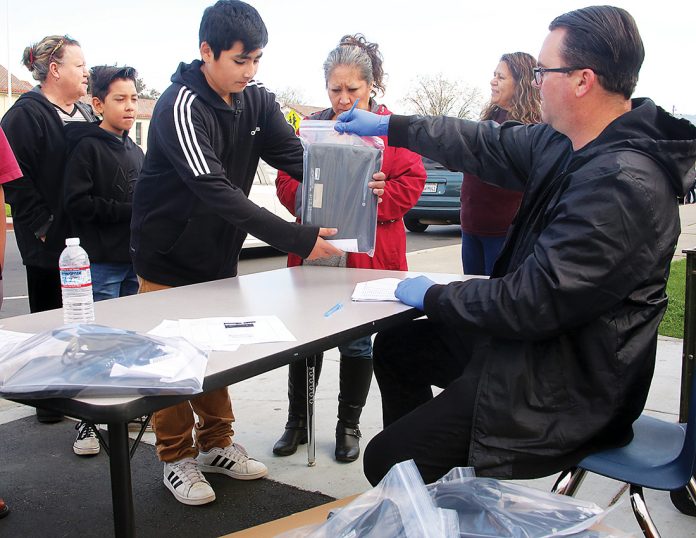
WATSONVILLE—Days after the Pajaro Valley Unified School District Board of Trustees voted to close all district schools for two weeks, allowing most employees and students to work from home, Gov. Gavin Newsom had a troubling message for educators, parents and students: expect more.
“I would plan and assume it’s unlikely that many of these schools, few if any, will open before the summer break,” Newsom told reporters during a press conference Wednesday.
The closures across the county, state and much of the nation come as one measure of a multifaceted approach to slow the transmission of coronavirus that includes a shelter-in-pace order throughout the Bay Area.
While teachers prepare packets of work and design lessons to be given online as part of “distance learning,” other staff is providing essential services such as preparing and handing out food, cleaning the schools and keeping PVUSD’s technology running.
PVUSD employees sent home thousands of Chromebooks with students on Thursday and Friday, along with wireless hotspots to help them access the internet.
Calabasas Elementary School fourth-grade teacher Laura Arnow said she has spent as many as three hours per day in virtual meetings with her grade-level team, as they prepare lessons to complete at home and look for ways to deliver digitally what they have previously done in the classroom.
“We’re scrambling,” she said.
At the same time, students districtwide were receiving the Chromebook computers they will use for their lessons, and many were hooking up new internet connections they will need to access the material.
But even as the district worked to provide the digital tools their students will need, some teachers worried that distance learning will be too much of a burden for families, when many parents work multiple jobs.
“Ag workers are still expected to show up at work, and now they have this extra job of educating their kids,” Arnow said.
Another trouble facing teachers, Arnow said, is being able to communicate with parents. Much of that is done through Class Dojo, a website that among other things allows educators and parents to communicate.
But encouraging parents to use the tool has been a challenge, she said.
“I have 28 kids on my roster, and of those 11 families aren’t responding to Class Dojo,” she said.
In addition, Arnow said, her team is tasked with providing five hours of content per day, only two hours of which can be online. But with libraries closed countywide – and giving out books to kids all but impossible thanks to social distancing requirements – that can be a tall order, Arnow said.
“Every person is facing a situation they never imagined, and for these 9- and 10-year-olds, it’s hard to imagine what it’s like for them,” she said. “It’s going to be interesting and unusual times for everyone. Kids are going to miss one-third of the year, and I don’t see any way to change that.”
PVUSD Superintendent Michelle Rodriguez said that the district is providing the devices – and technological support – so that parents don’t have to be the teachers. This includes a help hotline that opens March 23 at 786-2493.
Many students, Rodriguez said, have already been using Chromebooks daily in their classroom and have grown up surrounded by technology.
“Our students are digital natives,” she said. “I am pretty confident that if they have a computer that works and have access to the hotline that the students can manipulate their Chromebooks and access their lessons.”
A skeleton crew of Human Resources and other district office personnel are also staying on hand to keep day-to-day operations running.
County education officials announced the countywide closures on March 12, which they said would last for at least one week. That number quickly compounded as the number of confirmed cases grew. There are now 14 countywide.
In preparing lessons to be delivered via electronic means and homework packets, PVUSD teachers join colleagues nationwide in preparing for the increasing likelihood that the current school closures will last for more than two weeks. UC Santa Cruz has suspended all of its in-person classes until the end of the school year, and Cabrillo College and CSU Monterey Bay have similarly moved their instruction online through spring break.
“This is not going to go away in a few weeks, so we need to have continuity of learning,” Rodriguez said.
“The challenge we have is that we must together create weeks worth of curriculum,” she said.
Also during the time away from their classrooms, PVUSD is providing 4,300 meals every weekday to the students who depend on their schools for their breakfast and lunch.











